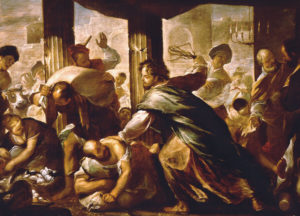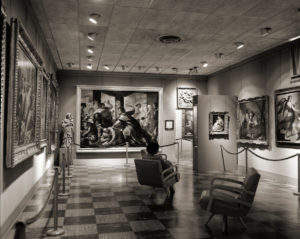Christ Cleansing the Temple
Oil on canvas, c. 1660
Luca Giordano, called Luca fa presto
Neapolitan, 1634–1705

As M&G celebrates 70 years this month, it is only appropriate to highlight a wonderful piece in the collection that has been a part of the museum since its inception. This canvas has often been referred to as a favorite of our visitors to the Museum & Gallery. Its imposing size and theme have left an indelible effect on many viewers since the beginning.

M&G is indebted to the generosity of Carl Hamilton (1886-1967) for this work. Carl Hamilton, art connoisseur and dealer, is credited with suggesting in 1948 the idea to Dr. Bob Jones Jr. of beginning a museum. Around the same time, he was also involved in the formation of the North Carolina Museum of Art in Raleigh. Dr. Bob found him to be very helpful and encouraging during the early acquisition years. Not only did Hamilton provide introduction to dealers, advise on purchases, and shape collecting criteria, he also gifted many pieces in the period furniture collection.
Hamilton’s upbringing in rural Pennsylvania with an alcoholic father and firm, loving mother shaped his outlook on life. Exposed to Methodism through his mother, it enabled him to not only preach on occasion, but also to influence others in practical and financial scenarios. As a capable entrepreneur, he paid his way through Yale with a business pf pressing suits and shining shoes. His ability to invest and create income allowed him to adopt a son, pay the tuition of many students, and become an industrialist that owned a significant share of copra production in the Philippines at that time. Later, when his interest in art grew, he was mentored by Joseph Duveen and Mr. and Mrs. Bernard Berenson. A lifelong bachelor, he owned an ornately decorated apartment in New York City covered with Old Master paintings, period furniture, and sculpture.
Baroque master Luca Giordano began his artistic career during his childhood in Naples, Italy. His father, Antonio, was his first teacher, and he ensured that one of the best contemporary artists available would instruct his son—master painter Jusepe de Ribera. Luca proved a talented artist and a fast-painting one, which earned him the nickname of “fa presto” meaning to “work fast” or “go quickly.” Over his lifetime, he painted more than 5000 works, not including frescoes and etchings. His career involved travel to Rome, Venice, and Florence; he also spent a decade in Spain, where he was court painter to King Charles II. Giordano was incredibly skilled and adaptive—he often adopted styles of other artists, whose works he encountered. Several of his contemporaries are also represented in our collection: Rubens, Preti, Veronese, and Dolci.
Completed in 1660, Giordono’s Christ Cleansing the Temple is recognized as one of his most important paintings in America. It measures 10 feet wide and over 7 feet high. Noticeable through the paint are three panels of coarse canvas woven together, which reflects a Neapolitan influence. The effect of golden lighting is indicative of his connection to Venetian artists during his mid-twenties, when he was creating this work.
The Gospels mention the temple cleansing four times. Matthew, Mark, and Luke refer to the event near the end of Christ’s ministry, during the final Passover just prior to Christ’s passion. However, John describes a temple cleansing that takes place at Passover during Christ’s first year of public ministry and reveals Christ’s reason for the cleansing. He was God incarnate, and His place of worship was being defiled by the dishonesty of the money exchangers. Tyrian currency was used to pay the temple tax since it was the closest form of currency to the old Hebrew shekel, and exorbitant rates were charged to exchange the money. Also, the sacrificial animals were in the only area of the temple grounds that non-Jewish people were allowed to worship—an expectation and promise that God Himself declared in Isaiah 56. The Gentiles were disregarded by temple authorities for the sake of commerce.
Since the painted narrative includes a quizzical-looking ox and ruffled doves near several broken eggs, Giordano may have referenced John’s account (Jn. 2:13-25), which includes a list of sacrificial animals: ox, sheep, and doves. With Christ positioned in the center forefront, the artist skillfully captures the turbulence that ripples throughout the scene using a drybrush technique and the drama of diagonal lines.
John Good, Security Manager
References:
- American Dionysus: Carl W. Hamilton (1886–1967), Collector of Italian Renaissance Art, Tiffany L. Johnston
- Botticelli to Tiepolo: Three Centuries of Italian Painting from Bob Jones University, Richard P. Townsend
Luca Giordano is also represented by two other works in the Collection: The Triumph of Miriam and St. Barbara.
Published 2021